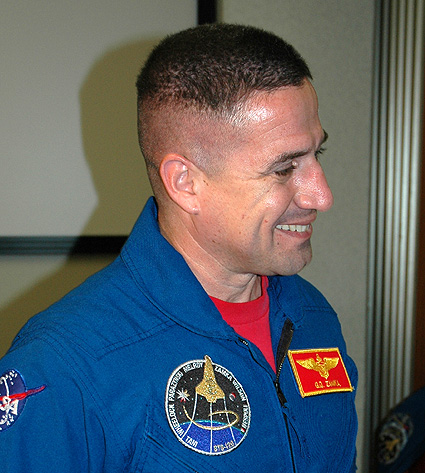
The Italian Aerospace Information Web
by Aeromedia - corso Giambone 46/18 - 10135 Torino (Italy)
George D. Zamka (Colonel, USMC) NASA Astronaut
DATA: Born in 1962 in Jersey City, New Jersey. Raised in New York City; Irvington, New York; Medellin, Colombia and Rochester Hills, Michigan. Married to the former Elisa P. Walker of Mississippi. They have two children. He enjoys weight lifting, running, bicycling, scuba and boating. His mother, Sofia Zamka and brother Conrad P. Zamka both live in Florida. His father, Conrad Zamka resides in Indiana.
EDUCATION: Graduated from Rochester Adams High School, Rochester Hills Michigan, in 1980; received a Bachelor of Science degree in Mathematics from the United States Naval Academy in 1984; received a Masters of Science degree in Engineering Management from the Florida Institute of Technology in 1997.
ORGANIZATIONS: United States Naval Academy Alumni Association, Marine Corps Association, and Society of Experimental Test Pilots.
SPECIAL HONORS: Navy Strike Air Medal (6), Navy Commendation Medal with Combat V, and various other military service and campaign awards. Distinguished Graduate, United States Naval Academy. Commodore’s list and Academic Achievement Award, Training Air Wing Five. Recipient of four NASA Superior Accomplishment Awards and a GEM Award.
EXPERIENCE: Zamka was commissioned as a Second Lieutenant in the United States Marine Corps after graduating from the United States Naval Academy in May 1984. After basic flight training, he was trained as an A-6E pilot at Whidbey Island, Washington in 1987-88. He then flew with Marine All Weather Attack Squadron VMA(AW)-242 in El Toro, California. He served in administration and flight safety roles and also as Squadron Weapons and Tactics Instructor. In 1990, he trained to be an F/A-18 pilot and was assigned to Marine All Weather Fighter Attack Squadron VMFA(AW)-121, also in El Toro. He flew the F/A-18D Night Attack Hornet during overseas deployments to Japan, Korea, Singapore, and Southwest Asia. Zamka flew 66 combat missions over occupied Kuwait and Iraq during Desert Storm. In 1993 he served with First Battalion, Fifth Marines in Camp Pendleton, California and the 31st Marine Expeditionary Unit in the Western Pacific. He was selected to attend the United States Air Force Test Pilot School class 94A and graduated in December 1994. Zamka was then assigned as an F/A-18 test pilot/project officer and the F/A-18 Operations Officer for the Naval Strike Aircraft Test Squadron (NSATS). While assigned to NSATS, Zamka flew a wide variety of tests in the F/A-18 Hornet to include high angle of attack, loads, flutter, crew equipment, and weapon system programs. Zamka returned to VMFA(AW)-121 in 1998 and was serving as the Aircraft Maintenance Officer, deployed to Iwakuni, Japan, when selected for the astronaut program.
He has over 4000 flight hours in more than 30 different aircraft.
NASA EXPERIENCE: Selected as a pilot by NASA in June 1998, he reported for astronaut candidate training in August 1998. He has served in various technical and leadership roles in the astronaut office, to include space rendezvous and proximity operations, landing and roll out instructor, and lead for shuttle systems within the Shuttle Operations Branch. Zamka served as lead for the shuttle training and procedures division and as supervisor for the astronaut candidate class of 2004. In 2007 he completed his first space flight as pilot on STS-120.
SPACE FLIGHT EXPERIENCE: STS-120 Discovery (October 23-November 7, 2007) launched from and returned to land at the Kennedy Space Center, Florida. During the mission, the Node 2 element named “Harmony” was delivered to the International Space Station. This element opened up the capability for future international laboratories to be added to the station. In addition, the P6 Solar Array was re-located from the Z1 Truss to the end of the port side of the Integrated Truss Structure. During the re-deploy of the array, the array panels snagged and were damaged. An unplanned spacewalk was successfully performed to repair the array. The mission was accomplished in 238 orbits, traveling 6.2 million miles in 15 days, 2 hours, and 23 minutes.
(NASA web-site / November 2007)
